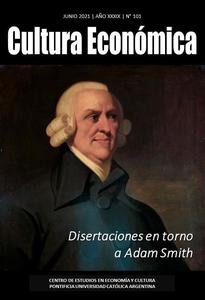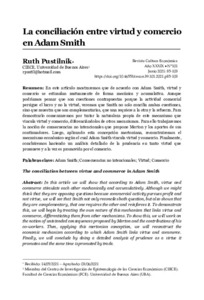Please use this identifier to cite or link to this item:
https://repositorio.uca.edu.ar/handle/123456789/11893| Título: | La conciliación entre virtud y comercio en Adam Smith The conciliation between virtue and commerce in Adam Smith |
Autor: | Pustilnik, Ruth | Palabras clave: | VIRTUD; Smith, Adam, 1723-1790; COMERCIO | Fecha de publicación: | 2021 | Editorial: | Pontificia Universidad Católica Argentina. Facultad de Ciencias Económicas. Centro de Estudios de Economía y Cultura | Cita: | Pustilnik, R. La conciliación entre virtud y comercio en Adam Smith [en línea]. Revista Cultura Económica. 2021, 39, (101). doi: 10.46553/cecon.39.101.2021.p85-103. Dispónible en: https://repositorio.uca.edu.ar/handle/123456789/11893 | Resumen: | Resumen: En este artículo mostraremos que de acuerdo con Adam Smith, virtud y comercio se estimulan mutuamente de forma mecánica y acumulativa. Aunque podríamos pensar que son cuestiones contrapuestas porque la actividad comercial persigue el lucro y no la virtud, veremos que Smith no solo concilia ambas cuestiones, sino que muestra que son complementarias, que una requiere a la otra y la refuerza. Para demostrarlo comenzaremos por tratar la naturaleza propia de este mecanismo que vincula virtud y comercio, diferenciándolos de otros mecanismos. Para ello trabajaremos la noción de consecuencias no intencionales que propone Merton y los aportes de sus continuadores. Luego, aplicando esta concepción mertoniana, reconstruiremos el mecanismo económico según el cual Adam Smith vincula virtud y comercio. Finalmente, concluiremos haciendo un análisis detallado de la prudencia en tanto virtud que promueve y a la vez es promovida por el comercio. Abstract: In this article we will show that according to Adam Smith, virtue and commerce stimulate each other mechanically and accumulatively. Although we might think that they are opposing questions because commercial activity pursues profit and not virtue, we will see that Smith not only reconciles both question, but also shows that they are complementary, that one requires the other and reinforces it. To demonstrate this, we will begin by treating the own nature of this mechanism that links virtue and commerce, differentiating them from other mechanisms. To show this, we will work on the notion of unintended consequences proposed by Merton and the contributions of his co-workers. Then, applying this mertonian conception, we will reconstruct the economic mechanism according to which Adam Smith links virtue and commerce. Finally, we will conclude by doing a detailed analysis of prudence as a virtue it promotes and the same time is promoted by trade. |
URI: | https://repositorio.uca.edu.ar/handle/123456789/11893 | ISSN: | 1852-0588 (impreso) 1852-5342 (on line) |
Disciplina: | ECONOMIA | DOI: | 10.46553/cecon.39.101.2021.p85-103 | Derechos: | Acceso abierto | Fuente: | Revista Cultura Económica 2021, 39(101) |
| Appears in Collections: | CECON - 2021 Año XXXIX nro. 101 |
Files in This Item:
| File | Description | Size | Format | |
|---|---|---|---|---|
| CECOM2021-101.jpg | 48,11 kB | JPEG |  View/Open | |
| conciliacion-virtud-comercio.pdf | 349,89 kB | Adobe PDF |  View/Open |
Page view(s)
115
checked on Apr 30, 2024
Download(s)
175
checked on Apr 30, 2024
Google ScholarTM
Check
Altmetric
Altmetric
This item is licensed under a Creative Commons License

